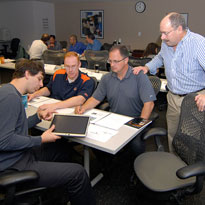Positioning & Location – Advanced
- Course:Positioning & Location – Advanced
- Course ID:ADVPL Duration:2 days Where: Your Office (7+ Persons)
- Download Course Description (PDF)
Available as a private, customized course for your group at your offices or ours and in some cases as a WebLive(TM) class.
Course Outline
Part 1: Review of Basics
- Positioning Methods
- Terrestrial vs. Satellite
- Geographic Information Systems (GIS)
- Data, Systems, and Management
- Location Management
- User Plane vs. Control Plane
- Standardized Architectures
- Call/Message Flows
Part 2: Next Generation Location
- What Is Next Generation Location?
- Leveraging NGN Architectures
- Leveraging IP, Data, and Non-voice Applications
- Leveraging Presence and Autonomous Methods
- Leveraging Ubiquity of Location-enabled Content and Applications
- Drivers for Next Generation Location
- Proliferation and Use of Smart-phones and Non-voice Communications
- Location Becomes Mainstream: Flat Hierarchy (Google) and Brokering (Loc-aid)
- Concerns for Personal Safety: NG 9-1-1 and Personal Safety Applications
- Deployment of NGN: IP Multimedia Subsystem (IMS)
- Consumer Acceptance of Location in their Daily Life
Part 3: NG Location Technologies, Solutions and Issues
- IP Systems
- Differences between IP and TDM
- Location and VoIP
- IP and Non-voice Applications
- Presence Systems
- What Is “Presence” in Telecommunications?
- Presence vs. Location
- Methods for Obtaining Presence
- Managing Presence Data
- Presence-based Applications
- IP Multimedia Subsystem (IMS) and Location
- NGN Intelligence: Introduction to IMS
- Inherent Presence in IMS: The Power of SIP
- Presence and Location Management in IMS
- Example Application: E 9-1-1 over IMS
- Identity Management Systems
- What Is Identity Management?
- Why Is Identity important to Presence and Location?
- Machine-to-Machine (M2M) Communications
- What is M2M?
- It’s Not Just about People: Tracking Assets, Telemetry and More
- Different Players and Rules Apply to M2M
- Location Brokering, Mediation, and Federation
- Presence and Location Intermediation
- Evolution and Business Model
- Network Entities, Business Entities, and Interactions
Part 4: NG Location Applications
- Public and Personal Safety
- NG 9-1-1
- Personal Safety Applications
- Presence and Autonomous Location-based
- Mobile Advertising/Marketing
- Mobile Commerce and Contactless Payments
- Social Networking and Location Sharing
- Homeland Security and Law Enforcement
- Behavior-based and Context-based Location Applications
- Places: Where have you been and Where are you Likely to Go?
- Things: What Do You Care About?
- Relationships: Who and What Do You Interact With?
- User Control: Who/What Is Allowed to Know All of This?
- Advanced Location Systems and Applications
- Location-based Augmented Reality
- Cross Platform: Mobile, PC, TV, Car, Kiosk, and More
- User Generated Content (UGC) and Syndication
- Autonomous Information Services: Info Finds You (and not vice versa)
Part 5: Role of the Location Mediator
- Location Mediation
- What is Location Mediation?
- Responsibilities of the Mediator
- Beyond Location Brokering
- Identity Management
- Quality of Service (Qos) and SLA’s
- Billing and Settlement
- Network and Protocol Interoperability
Part 6: NG Location Challenges
- Privacy and Security
- Consumer Acceptance
- Network Readiness
- Legal and Regulatory
Part 7 – Workshop: Designing an NG Location Application/System*
- Application Design
- Commercial vs. Non-commercial
- Unique Requirements for Application
- System Design
- Positioning Requirements
- Location Management Requirements
- GIS Requirements
- Other Requirements
* Instructor-provided choices of applications are provided
Part 8: State of the Art for NG Location
- North America
- Latest FCC Order
- Public and Personal Safety
- Homeland Security
- Middle East
- Saudi Arabia
- Asia Pacific
- India
- Australia
Part 9: Anticipated Developments
- Pervasive and Presence and Location Becomes Practical
- Device Improvements: Smarter, Faster Processors, Better Batteries
- Hierarchical approach to Presence/Location
- More Data Capacity: 4G and Beyond
- Homeland Security and Law Enforcement
- Tracking and Profiling
- Selective Denial of Service
- Consumer Identity and Location Verification
- Identity and Behavior Theft Prevention
- Selective Denial of Service
- Advanced M2M Communications
- Machines talking to Machines (and they are all location and context aware)
- M2M and Humans: Machine-assisted, Location-aware Applications
- Wrap-up
- Course recap
- Discussion
- Participant Evaluation of the Course
Course in a Nutshell
There is no other attribute that better defines mobile communications than mobility and no better asset than location. Effectively leveraging this asset is based on the ability to determine the position of the target mobile device, obtain the position data from cellular network, and resolve the data into useful and context specific location information.
The course starts with an overview of positioning methods, geographic information systems, and location management. It assumes a basic understanding of these technologies and solutions associated with the recommended prerequisite course. It defines next generation network (NGN) location and teaches NGN location systems and solutions including the role of Internet protocol, presence and identity, and location in IP Multimedia Subsystem (IMS). It includes advanced topics such as location in machine-to-machine (M2M) communications, location mediation, and more. It also evaluates NGN location applications and includes a network and application design workshop. It concludes with a state-of-art review for NGN location and analysis of anticipated developments in NGN location technologies, solutions, and applications.
Customize It!
This course can be extended or shortened as needed. It can also be revised to cover the positioning and location methods or applications of particular interest to your group. If your group lacks the prerequisites, we can extend the course to cover those upfront to the extent required.
Aimed At
This course is aimed at those interested in the commercial, public safety, law enforcement, homeland security, or national defense application of positioning and location technologies.

